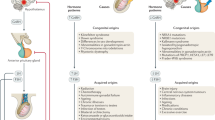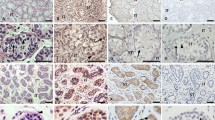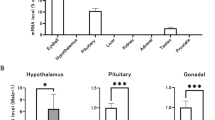Abstract
Leydig cell hypoplasia is a rare autosomal recessive condition that interferes with normal development of male external genitalia in 46,XY individuals. We have studied two Leydig cell hypoplasia patients (siblings born to consanguineous parents), and found them to be homozygous for a missense mutation (Ala593Pro) in the sixth transmembrane domain of the luteinizing hormone (LH) receptor gene. In vitro expression studies showed that this mutated receptor binds human choriogonadotropin with a normal KD, but the ligand binding does not result in increased production of cAMP. We conclude that a homozygous LH receptor gene mutation underlies the syndrome of autosomal recessive congenital Leydig cell hypoplasia in this family. These results have implications for the understanding of the development of the male genitalia.
This is a preview of subscription content, access via your institution
Access options
Subscribe to this journal
Receive 12 print issues and online access
$209.00 per year
only $17.42 per issue
Buy this article
- Purchase on Springer Link
- Instant access to full article PDF
Prices may be subject to local taxes which are calculated during checkout
Similar content being viewed by others
References
Jost, A. Hormonal factors in the sex differentiation of the mammalian foetus. Philos. Trans. R. Soc. Lond. Biol. 259, 119–130 (1970).
Nordqvist, K. & Lovell-Badge, R. Setbacks on the road to sexual fulfilment. Nature Genet. 7, 7–9 (1994).
Huhtaniemi, I. Fetal testis—a very special endocrine organ. Eur. J. Endocrinol. 130, 25–31 (1994).
Patsavoudi, E., Magre, S., Castanier, M., Scholler, R. & Jost, A. Dissociation between testicular morphogenesis and functional differentiation of Leydig cells. J. Endocrinol. 105, 235–238 (1985).
Schwartz, M. et al. Male pseudohermaphroditism secondary to an abnormality in Leydig cell differentiation. J. clin. endocrinol. Metab. 53, 123–127 (1981).
Martinez-Mora, J. et al. Male pseudohermaphroditism due to Leydig cell agenesia and absence of testicular LH receptors. Clin. Endocrinol. 34, 485–491 (1991).
Perez-Palacios, G. et al. Inherited male pseudohermaphroditism due to gonadotrophin unresponsiveness. Acta. Endocrinol. 98, 148–55 (1981).
Lee, P.A. et al. Leydig cell hypofunction resulting in male pseudohermaphroditism. Fertil. Steril. 37, 675–679 (1982).
Toledo, S.P.A., Amhold, I.J., Luthold, W., Russo, E.M. & Saldanha, P.H. Leydig cell hypoplasia determining familial hypergonadotropic hypogonadism. Prog. Clin. Biol. Res. 200, 311–314 (1985).
Toledo, S.P.A. Leydig cell hypoplasia leading to two different phenotypes: male pseudohermaphroditism and primary hypogonadism not associated with this Clin. Endocrinol. 36, 521–522 (1992).
EI-Awady, M.K., Temtamy, S.A., Salam, M.A. & Gad, Y.Z., Familial Leydig cell hypoplasia as a cause of male pseudohermaphroditism. Hum. Hered. 37, 36–40 (1987).
Saldanha, P.H., Amhold, I.J., Mendonca, B.B., Bloise, W. & Toledo, S.P.A. A cllnico-genetlc investigation of Leydig cell hypoplasia.Am J. med. Genet. 26, 337–344 (1987).
Arnhold, I.J. et al. Leydig cell hypoplasia causing male pseudohermaphroditism: case report and review of the literature. Rev Hosp. Clin. Fac. Med. Sao Paulo. 42, 227–232 (1987).
Warren, D.W., Huhtaniemi, I.T., Tapanainen, J., Dufau, M.L. & Catt, K.J. Ontogeny of gonadotropln receptors in the fetal and neonatal rat testis. Endocrinology. 114, 470–476 (1984).
Braun, T., Schofield, P.R. & Sprengel, R. Amino-terminal leucine-rich repeats in gonadotropin receptors determine hormone selectivity. EMBO J. 10, 1885–1890 (1991).
Shenker, A. et al. A constitutively activating mutation of the luteinizing hormone receptor in familial male precocious puberty. Nature. 365, 652–654 (1993).
Kremer, H. et al. Cosegregation of missense mutations of the luteinizing hormone receptor gene with familial male-limited precocious puberty. Hum. molec. Genet. 2, 1779–1783 (1993).
Clements, J.A., Reyes, F.I., Winter, J.S. & Faiman, C. Studies on human sexual development. III. Fetal pituitary and serum, and amniotic fluid concentrations of LH, CG, and FSH. J. clin. endocrinol. Metab. 42, 9–19 (1976).
Huhtaniemi, I.T., Korenbrot, C.C. & Jaffe, R.B. HCG binding and stimulation of testosterone biosynthesis in the human fetal testis.J clln endocrinol. Metab. 44, 963–967 (1977).
Huhtaniemi, I. & Pelliniemi, L.J. Fetal Leydig cells: cellular origin, morphology, life span, and special functional features. Proc. Soc. Exp. Biol. Med. 201, 125–140 (1992).
Zhang, F.P., Hamalainen, T., Kaipia, A., Pakarinen, P. & Huhtaniemi, I. Ontogeny of luteinizing hormone receptor gene expression in the rat testis. Endocrinology. 134, 2206–2213 (1994).
Molenaar, R., de Rooij, D.G., Rommerts, F.F.G. & van der Molen, H.J. Repopulation of Leydig cells in mature rats after selective destruction of the existent Leydig cells with ethylene dimethane sulfonate is dependent on luteinizing hormone and not follicle-stimulating hormone. Endocrinology 118, 2546–2554 (1986).
Kuopio, T., Pelliniemi, L.J. & Huhtaniemi, I., Rapid Leydig cell proliferation and luteinizing hormone receptor replenishment in the neonatal rat testis after a single injection of human chorionlc gonadotropin. Biol. Reprod. 40, 135–143 (1989).
Murono, E.P., Washbum, A.L. & Goforth, D.P. Enhanced stimulation of 5 alpha-reductase activity in cultured Leydig cell precursors by human chononic gonadotropin. J. Steroid Biochem. molec. Biol. 48, 377–384 (1994).
George, F.W., Catt, K.J., Neaves, W.B. & Wilson, J.D. Studies on the regulation of testosterone synthesis in the fetal rabbit testis. Endocrinology 102, 665–673 (1978).
Miller, S.A., Dykes, D.D. & Polesky, H.F. A simple salting out procedure for extracting DNA from human nucleated cells. Nucl. Adds Res. 16, 1215 (1988).
Minegishi, T. et al. Cloning and sequencing of human LH/hCG receptor cDNA. Biochem. Biophys. Res. Comm. 172, 1049–1054 (1990).
Green, S., Issemann, I. & Sheer, E. A versatile in vivo and in vitro eukaryotic expression vector for protein engineering. Nucl. Acids Res. 16, 369 (1988).
Higuchl, R., Krummel, B. & Saiki, R.K. A general method of in vitro preparation and specific mutagenesis of DNA fragments: study of protein and DNA interactions.Nucl. Acids Res. 16, 7351–7367 (1988).
Chen, C. & Okayama, H. High-efficiency transformation of mammalian cells by plasmid DNA. Molec. Cell. Biol. 7, 2745–2752 (1987).
Ketelslegers, J.M. & Catt, K.J. Follitropin receptors in rat testis. Characterization with enzymatically 125l-labeled human follitropin. Biochlm. Biophys. Acta. 541, 360–371 (1978).
van Dijk, M.A., van Schalk, F.M., Bootsma, H.J., Holthuizen, P. & Sussenbach, J.S. Initial characterization of the four promoters of the human insulin-like growth factor II gene. Molec. Cell. Endocrinol. 81, 81–94 (1991).
Themmen, A.P.N. et al. Follitropin receptor down-regulation involves a cAMP-dependent post-transcriptional decrease of receptor mRNA expression. Mol. Cell. Endocrinol. 78, R7–13 (1991).
Stoof, J.C., Vertieijden, P.F. & Leysen, J.E. Stimulation of D2-receptors in rat nucleus accumbens slices inhibits dopamine and acetylcholine release but not cyclic AMP formation. Brain Res. 423, 364–368 (1987).
Blok, L.J. et al. Transcriptional regulation of androgen receptor gene expression in Sertoli cells and other cell types. Molec. Cell Endocrinol. 88, 153–64 (1992).
Author information
Authors and Affiliations
Rights and permissions
About this article
Cite this article
Kremer, H., Kraaij, R., Toledo, S. et al. Male pseudohermaphroditism due to a homozygous missense mutation of the luteinizing hormone receptor gene. Nat Genet 9, 160–164 (1995). https://doi.org/10.1038/ng0295-160
Received:
Accepted:
Issue Date:
DOI: https://doi.org/10.1038/ng0295-160
This article is cited by
-
A novel variant luteinizing hormone receptor in the first transmembrane helix of two homozygous Iranian patients: case report
Egyptian Journal of Medical Human Genetics (2022)
-
A Toolkit for the Application of Placental-Fetal Molecular Biomarkers in Epidemiologic Studies of the Fetal Origins of Chronic Disease
Current Epidemiology Reports (2021)
-
Novel mutations in LHCGR (luteinizing hormone/choriogonadotropin receptor): expanding the spectrum of mutations responsible for human empty follicle syndrome
Journal of Assisted Reproduction and Genetics (2020)
-
Structure and activation of the TSH receptor transmembrane domain
Autoimmunity Highlights (2017)



